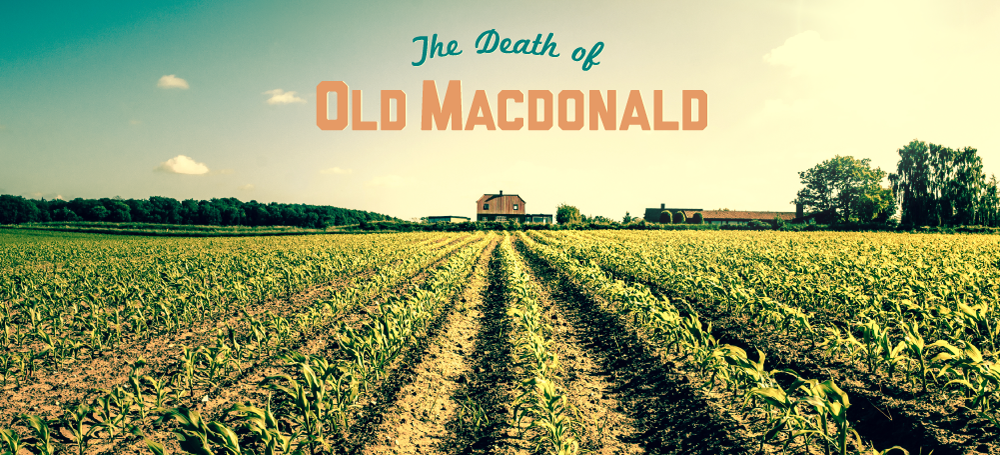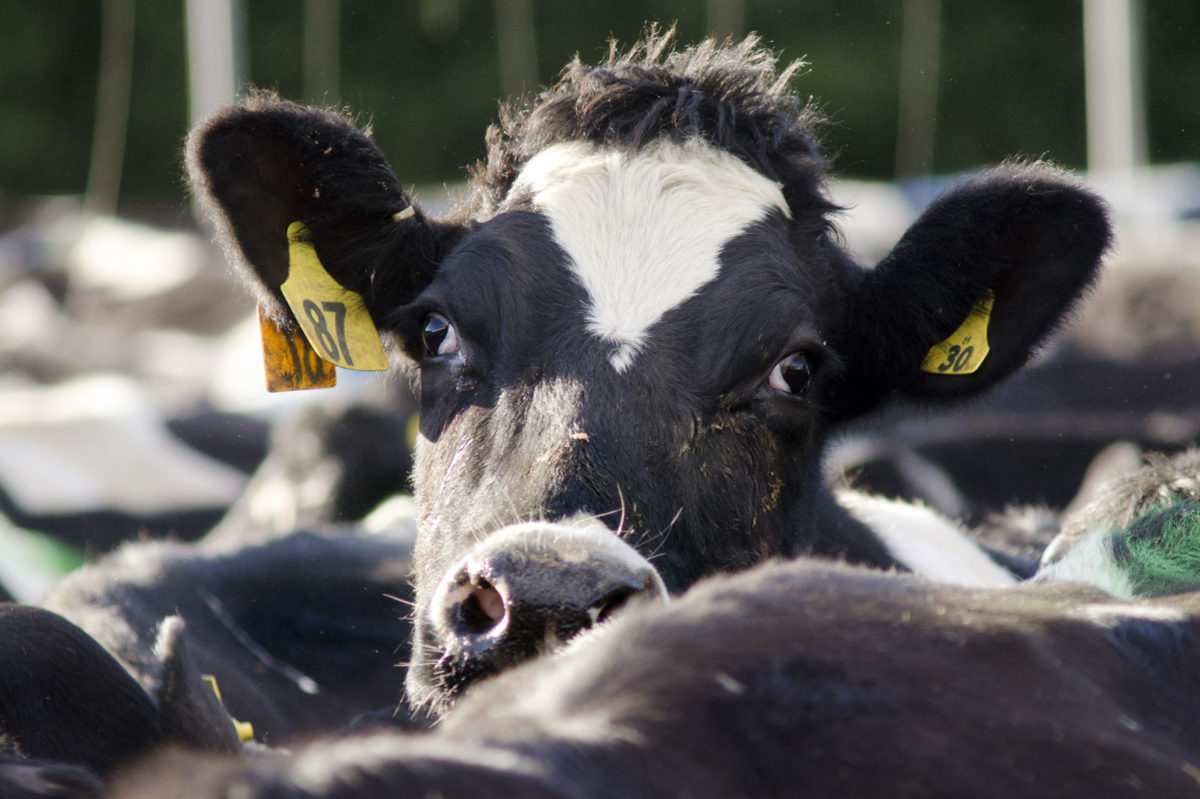CELDF has assisted the first communities in the United States to prohibit factory farming and other industrial agricultural practices. Below learn about the perils of factory farming, how communities are organizing to stop them, and what you can do in your own community.
Factory Farming or “Intensive Farming” is characterized by aggressive tactics to increase agriculture and livestock yields in the search for profits. Factory farming has grown through the years in direct proportion to the consolidation of wealth in America. This corporatization of agriculture means that fewer and fewer people are controlling the production of our food, and causing more and more harm to our environment.

The Death of Old MacDonald
If Old MacDonald had a farm, that farm no longer exists. It was purchased by a corporation. A few corporations in America have managed to buy nearly every family farm across the nation. In 1930, there were 7 million farms. Today, there are fewer than 2 million, and only 25% of those remaining are family-run operations. Each week, it’s estimated that 330 farms close their doors forever. Fewer hands now hold more control over our food production and our environment than ever before.[1]
Why does it matter?
The system is rigged. A small handful of large corporations are involved in all aspects of the food industry: the growing and raising of vegetables and animals, processing of food products, and the selling of those goods. These monopolies not only hurt the communities where family-owned farms are struggling to thrive, but they control the price that everyone pays (literally and figuratively), affecting the economic well-being and health of families and communities across the country. [2]
The effects of large corporations operating in rural communities have devastating consequences for the health of the land and the communities that are established nearby.[3] Factory farming is part of an unsustainable system whereby corporations seek profits, regardless of harms. For over 200 years, the laws in America have been tailored for just that: the expansion and protection of corporate profits, at the cost of our communities.
Factory farms are inhumane
In America, there is a contradiction in the way we treat animals. We value and cherish our pets, enjoy encounters with wildlife, and overwhelmingly agree that cruelty to animals is wrong. However, under the current animal cruelty laws in most states, if we treated our family pets the same way that factory farm animals are treated, it would be considered a felony.
Animals raised by factory farms are in habitats so unnatural that the government doesn’t even consider the facilities to be farms. They are called “Animal Feeding Operations” or AFOs. These factories are defined by the EPA as “agricultural enterprises where animals are kept and raised in confined situations. AFOs congregate animals, feed, manure and urine, dead animals, and production operations on a small land area. Feed is brought to the animals rather than the animals grazing or otherwise seeking feed in pastures, fields, or on rangeland.” And, according to the EPA, there are approximately 450,000 AFOs in the United States.[4] 450,000 facilities that employ inhumane tactics such as confinement and mutilation to produce meat, eggs, and dairy for as much profit as possible.
Supposed supply and demand
Corporations tell us the tactics they employ are necessary to keep up with food demand. But in reality, these claims are easily disproven when you examine the yields of the factory farming system.
Take American dairy production. Dairy farms have concentrated more and more cows into warehouse-like conditions, closing 50,000 family-run dairy farms between 1997 and 2007. Yet milk production levels remain the same. Similar to the dairy industry, the pork industry has become just as concentrated, but raises the same number of hogs today as were raised in 1950.
An unsustainable system
Each year, 10 billion animals are raised for food, far exceeding the total population of people on earth.[2] A single dairy cow produces 80 pounds of waste each day. The manure from a 200 cow dairy produces as much nitrogen as the sewage from a community of 5,000 to 10,000 people. In fact, the U.S. Department of Agriculture estimates that factory farms produce over 450 million tons of manure each year. That is three times the waste produced by the human population in America.[5] The compound effect of this kind of waste alone is more than the environment can manage.
Lagoon is too nice a word for a manure pit
One of the common components of any factory farm is a “lagoon” for storing animal waste. These reservoirs of liquid manure not only create an offensive odor, but are vulnerable when flooding occurs, sending animal waste into rivers, harming ecosystems, and threatening nearby communities.
In the aftermath of Hurricane Floyd in 1999, 25 million gallons of hog waste contaminated the New River in Onslow County, North Carolina, flooding roads and fields in knee-deep pig sewage, devastating river life and affecting ocean shellfish for hundreds of miles up and down the Atlantic coast. Even worse, when given the opportunity to pass a bill that would give farms incentive to dispose of waste in a more environmental-friendly fashion, the General Assembly in North Carolina (the second leading hog producing state in the US)[11] failed to approve it.[12]
Something in the water
Animal waste that comes from factory farms contains disease-causing pathogens such as salmonella, e. coli Cryptosporidium, and fecal coliform.[6] All these components are a normal part of fecal matter, but not a normal part of drinking water. A dairy factory farm in Milwaukee is believed to have caused the disastrous Cryptosporidium contamination in 1993 after the pathogen permeated the water supply, sickening 400,000 people, killing 100, and resulting in 37 million dollars in lost wages and productivity.
Ozone depletion and Demand for Fossil Fuels
Factory farming is extremely inefficient and is a heavy tax on Earth’s dwindling fossil fuels. Each year, it’s estimated that 41 million metric tons of CO2 are released through the burning of fossil fuels to produce fertilizers for animal feed crops.[7] The average transport from farm to market is 1,500 miles, using even more fossil fuels and furthering carbon emissions into the atmosphere. Factory farming is not only bad for the environment that we all share, but it’s bad for the health of local communities in countless ways.
Not a good next door neighbor
Evidence suggests that living near a factory farm decreases basic quality of life.[8] Strong odors force residents to keep their windows closed and stay in their homes, depriving them of spending time outdoors. To make matters worse, the odor isn’t only offensive. It’s harmful. The odors emitted from factory farms, especially hog farms, contain hydrogen sulfide, a gas that can cause flu-like symptoms in humans and has even been linked to brain damage. A 2003 survey given to a group of rural Iowans reported that after living near a pig farm, they would rather be neighboring a prison, landfill, or sewage treatment plant instead.[8] Emerging studies are showing that people next to factory farms are at higher risk for respiratory problems, neurobehavioral disorders, and mental illnesses. In one study, residents outside a large hog farm reported high instances of headaches, running noses, diarrhea, coughing, sore throat, and burning eyes.
Superbugs
Housing so many animals in such close quarters requires strong antibiotics to manage potential disease. Additionally, antibiotics are given to animals to make them grow faster, resulting in more “product” in a shorter time period. The problem is that these antibiotics are being passed on to the population through consumption and animal waste, contributing to antibiotic resistance that results in 2 million infections each year.[9] According to the National Academy of Sciences, “For the United States as a whole, the American Society for Microbiology estimated in 1995 that health care costs associated with treatment of resistant infections amounted to more than $4 billion annually. And this figure significantly underestimates the actual cost of resistance, since it includes only direct healthcare costs and excludes an array of other costs, such as lost lives and lost workdays.” [10]
Shopping differently won’t bring change
Our eating choices have a huge impact on the world around us, and corporations will always follow the demand of the people. But simply buying organic and local won’t change the system. Lasting change will come through challenging and changing our structure of law and governance by elevating community rights over corporate privileges and profits. Communities uniting together and fighting back will help challenge legal precedents that bestow corporate claimed “rights,” and begin to change the current paradigm.
Why is Factory Farming allowed to continue?
Big, corporate farms mean big business, and big dollars wield a lot of power in this country. While most of us were taught that the U.S. Constitution was written to protect the rights of human beings, communities regularly witness agribusiness corporations wielding the constitution to override community decision-making. When residents try to prevent a corporation from moving in, they are threatened with a lawsuit for violating the corporation’s “rights.”
Worse, residents confronting factory farm operations learn that their state government – with the help and at the behest of corporations – has legally authorized factory farming to take place. Laws such as Pennsylvania’s Right to Farm Act, define factory farming as a normal agricultural activity and prohibit municipalities from stopping or even regulating it. In Pennsylvania, the state legislature went even further, passing Act 38, which empowers the state Attorney General to sue a community if they try and stop factory farming.

What can you do?
The Community Environmental Legal Defense Fund has been at the forefront of this issue, helping residents, local groups, and municipal officials ban factory farms near their homes, and create the communities they envision. CELDF provides grassroots organizing, legal counsel, and education to communities affected by factory farming through programs like Democracy School, presenting at community and municipal meetings, and providing other grassroots support.
CELDF is writing the book on community rights
In 2000, CELDF spearheaded the first anti-corporate farm ownership ordinance in Wells Township, Fulton County, Pennsylvania, which prohibits corporations from engaging in agriculture. Since then, we have assisted dozens of other communities to protect against factory farming. Our ordinances have evolved, resulting in the current Sustainable Farm Ordinance, and our work has grown as we’ve helped dozens of communities establish Community Rights.
Take action. Stand up to factory farms.
If you or your community is threatened by factory farming, or trying to stop a factory farm from establishing itself in your community, contact CELDF and learn how to take action. You and your community have rights, and CELDF is here to help you fight for them.
Sources:
[1] Nothwehr, Dawn M. Ecological Footprints: An Essential Franciscan Guide for Faith and Sustainable Living.Collegeville, MN: Liturgical, 2012. Pg. 236. Ebook.
[2] https://www.organicconsumers.org/news/why-monsantos-gm-seeds-are-undemocratic
[3] U.S. Department of Agriculture, Economic Research Service. (1995). Understanding rural America: Rural change (AIB-ERSAIB710). (Found from http://www.sustainabletable.org/491/food-economics)
[4] http://www.epa.gov/agriculture/anafoidx.html
[5] WinthropMaine.org (Ibd.)
[6] “Hormones and Pharmaceuticals Generated by Concentrated Animal Feeding Operations.” Emerging Topics in Ecotoxicology (2009): n. pag. Web.
[7] Koneswaran, Gowri, and Danielle Nierenberg. “Global Farm Animal Production and Global Warming: Impacting and Mitigating Climate Change.” Environmental Health Perspectives. National Institute of Environmental Health Sciences, n.d. Web. 07 Aug. 2015.
[8] “Impact from Agriculture on Rural Tourism.” Landscape Amenities (2005): 69-85. An HSUS Report: The Impact of Industrialized Animal Agriculture on Rural Communities. Web.
[9] “THE THREAT OF ANTIBIOTIC RESISTANCE.” N.p., n.d. Web.
[10] http://books.nap.edu/openbook.php?isbn=0309088542&page=108
[11] https://web.duke.edu/mms190/hogfarming/
[12] http://www.ncglobaleconomy.com/hog/overview.shtml
